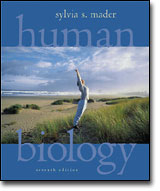|
 |  Human Biology, 7/e Dr. Sylvia S. Mader
Conservation of Biodiversity
Chapter Outline
25.1 Conservation Biology and BiodiversityConservation biology addresses a crisis-the loss of biodiversity. 498Conservation biology is an applied, goal-oriented, multidisciplinary field. 498Extinction rates have risen to many times their natural levels, and many types of ecosystems are disappearing. 498Biodiversity includes species diversity, genetic diversity, community diversity, and landscape diversity in marine, freshwater, and terrestrial habitats. 498 |
 |  |  | 25.2 Value of BiodiversityBiodiversity has both direct and indirect value. 500, 502 |
 |  |  | 25.3 Causes of ExtinctionHabitat loss, introduction of alien species, pollution, overexploitation, and disease are now largely responsible for the loss of biodiversity. 504Global warming will shift the optimal range of many species northward and disrupt many coastal ecosystems. 506 |
 |  |  | 25.4 Conservation TechniquesBecause of fragmented habitats, it is often necessary to conserve subdivided populations today. 508Identifying and conserving biodiversity hotspots and/or keystone species can save many other species as well. 508Computer analyses can be done to select areas for preservation and to determine the minimal population size needed for survival. 509Ecological preservation often involves restoration of habitats today. 510 |
|
|



 2002 McGraw-Hill Higher Education
2002 McGraw-Hill Higher Education